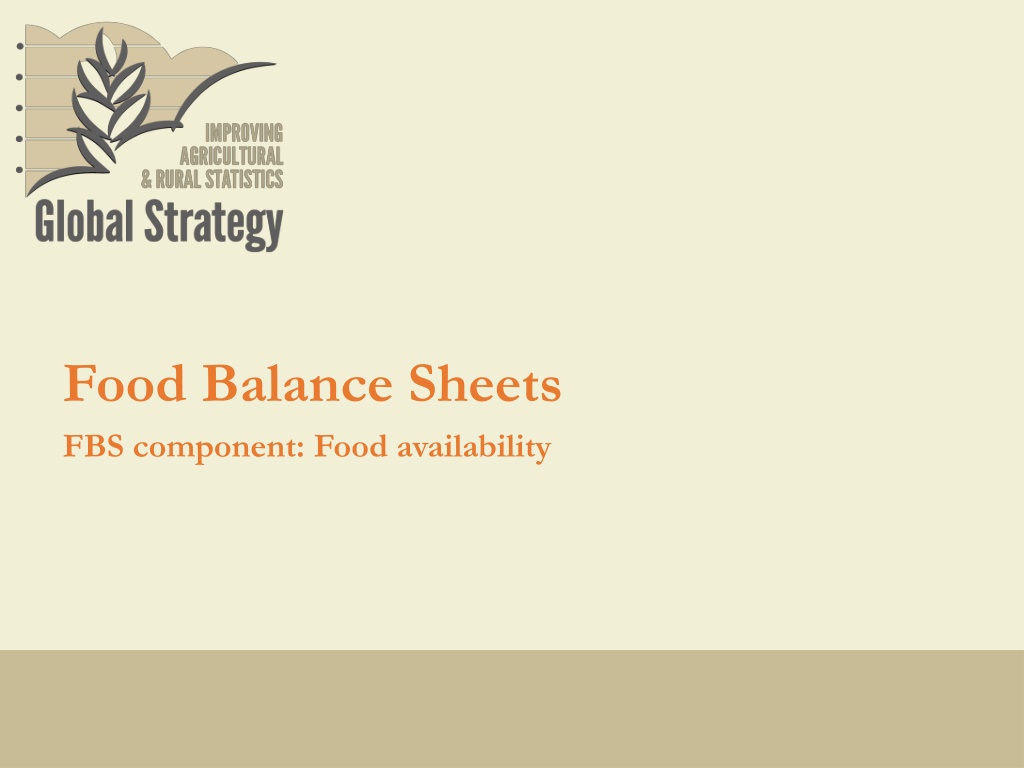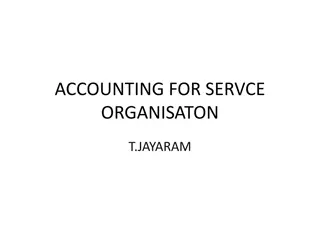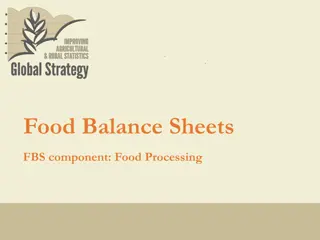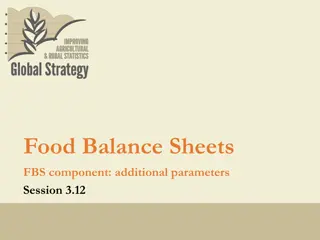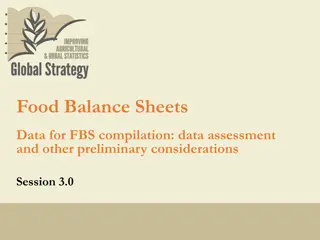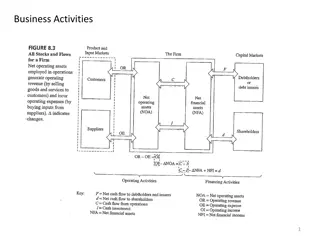Understanding Food Availability in Food Balance Sheets
Understanding the concept of food availability in Food Balance Sheets (FBS) is essential for estimating food data. This includes sources of data, estimation methods, and the distinction between food availability and consumption. Learn about the importance of accurate data measurement and the role of official and alternative data sources in assessing food availability.
Download Presentation

Please find below an Image/Link to download the presentation.
The content on the website is provided AS IS for your information and personal use only. It may not be sold, licensed, or shared on other websites without obtaining consent from the author. Download presentation by click this link. If you encounter any issues during the download, it is possible that the publisher has removed the file from their server.
E N D
Presentation Transcript
Food Balance Sheets FBS component: Food availability
Learning objectives The participants will know: a) What Food availability data are and their role in the FBS setting b) What are the Food availability data sources (official and not) c) How to estimate Food availability data 2
Outline I. II. Data sources: a. Official data sources b. Alternative data sources III. Imputation and Estimation a. Recommended Approach b. Alternative Approach Concept of Food Availability in the FBS setting 3
Concept of Food Availability Food availability (in the FBS setting) refers to quantities of any substance, whether raw, processed or semi- processed (including drinks) consumption during a given reference period at the retail level by the country s resident population. available for human IN OUT Any loss or waste at the retail or consumer level Food available for refugees and guest workers? Food available for tourists (Tourist Food component of the FBS) 4
Concept of Food Availability (Cont.) Food availability, not food consumption! Apparent food consumption != Effective food consumption Food availability from FBS > Food Consumption from NHS (especially in the developed countries) Dietary Energy Supply (DES) estimates are based on food availability estimates at SUA level! 5
Data Measurement Issue Directly measured data are difficult to obtain. Estimates can be derived by making certain adjustments to other existing datasets measuring food production or consumption. Key issue: ounderstanding exactly how the measured quantities differ from the FBS food availability definition oensuring that each one of these differences is accounted for in the adjustment process (recommended action) 6
Food availability data Sources Official data sources: Industrial output surveys Household consumption or expenditure surveys Alternative data sources: Not official channels (e.g. industry groups, processor associations or a handful of firms) Check the representativeness representativeness of the data and make adjustments as necessary (e.g. if a wheat flour millers association represents approximately 80% of the total market, it is possible to derive a total production of flour used for food simply by dividing by 0.8) adjustments 7
Industrial Output Surveys Official data on food availability from food processors (including flour mills, oilseed crushers, dairy processors, or breweries) Data are useful for food estimates because they represent so- called bottleneck industries o e.g. wheat industry (not in all countries) Wheat in primary form Fed to livestock transformation Food for human consumption Wheat flour 8
Industrial Output Surveys (Cont.) Cons: Data needs to represent a large proportion of total production (these sources are useful) Data sources will only be available to facilitate estimation of foods that are processed (e.g. fresh fruits and vegetables are excluded) Estimates of industrial output for food manufacturers may in some cases only be available in value terms Output data for food processors are technically production quantities and not food availability values for those SUA-level items (e.g. other uses must be netted out) Pro: Data will cover processing use for all consumption occurring within a country (including schools, hospitals, jails, or military installations) 9
Household Surveys (HS) Official data on food consumption at the household level: Do not cover all consumption occurring within a country in a given period (e.g. exclude food consumed outside of the home ) HS data represent conceptually a lower bound for food availability. Even if calorie estimates can vary widely between HS and FBS, shares of individual food groups in overall consumption (HS data) or availability (FBS data) tend to remain consistent (see Gr nberger, 2014) HS data may prove very useful in estimating or imputing food availability, provided that FBS compilers take note of, and adjust for, the other limitations of household surveys. 10
Household Surveys (Cons.) Limitations: Data collected for a brief period of time Infrequent data collection (e.g. every 4 or 5 years) HS may miss some under-represented subgroups (biased consumption estimates) HS will entirely miss consumption occurring restaurants/public, schools, prisons, hospitals, and military installations HS often collect data only in expenditures and not quantities Surveys will not include any accounting for food waste at the retail level, and may not include food waste at the household level either, potentially underestimating total food availability 11
Imputation and Estimation Recommended Approach: modelling food availability in the current year based on availability levels in the previous year, but by making adjustments for changes in income, population and the overall trend in food availability. Linear equation for food availability (using only population, trend, and food use in the previous period): is the historical trend in food availability (e.g. growth rate). It should be estimated from a regression on the historical data series. 12
Imputation and Estimation (Cont.) Recommended Approach: Semi-log equation for food availability (using additional information): ??????????? ??????????? 1 ?????? ??? ??????? ?????? ??? ??????? 1 ?????= ????? 1 1 + ? + log + ? = % demand / % income, is the product-specific elasticity of demand (e.g. = 0.1 for a given good indicates that for every 10% increase in income, demand for the product rises by 1%) o Data on for food categories are produced by USDA (2010) If Income is not available please use a proxy as GDP ( formula is still valid) There is some suggestion to substitute GDP with consumption from the National Accounts. This option will be evaluated in a short time. 13
Imputation and Estimation (Cont.) Alternative Approach: food availability is calculated as the balance of production minus net trade (and any other small utilization elements) Cons: in food use will accumulate all of the error from the other utilization elements. It is most appropriate for products that have no or few other utilizations. Note: in the final validation and balancing process, food availability estimated using either approach may be adjusted. 14
Reference 3rdchapter of the Guidelines: 1. Data for FBS compilation: considerations, sources and imputation 3.4 Food Availability 2. Gr nberger, K. 2014. Estimating Food Consumption Patterns by Reconciling Food Balance Sheets and Household Budget Surveys. FAO Statistics Division Working Paper Series No. ESS/14-08. Available at: http://www.fao.org/3/a-i4315e.pdf. Accessed on 19 January 2017. 3. USDA (2005). This database is publicly available, at: http://www.ers.usda.gov/data-products/international-food- consumption-patterns.aspx. 15 15
